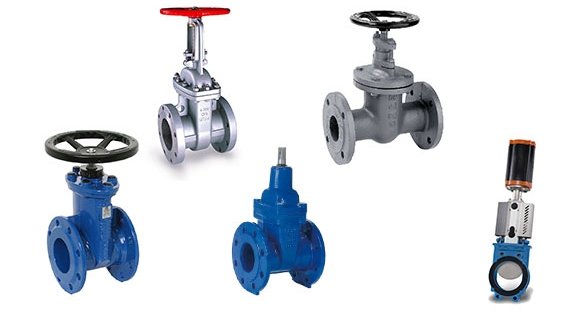The Advantages and Disadvantages of Gate Valves

A valve is a control device used to alter the channel section and medium flow direction in a pipeline fluid transportation system. It can be used to divert, turn off, throttle, check, divert, or relieve overflow. Every valve has a unique set of effects as well as advantages and disadvantages. One of the most popular forms of isolation valves is the industrial gate valve. They are widely used in pipelines to link external equipment to a system or to provide flow control. These valves are used in a wide range of pressure, temperature, and caliber applications.
The gate valve’s applicability for a given application must be determined by weighing its benefits and drawbacks. In this post, we’ll talk about the gate valve’s advantages and disadvantages.
What is Gate Valve?
A gate valve is a linear motion valve that is used to initiate or halt fluid flow; it does not control or throttle flow.
When a gate valve is fully opened, the disc is entirely withdrawn from the flow stream. When the valve is open, this feature gives almost minimal flow resistance. The pressure loss over an open gate valve is therefore minimal.
A 360° contact surface between the disc and the seal ring exists when the valve is fully closed, resulting in effective sealing. When the gate valve is closed, there is little to no leakage across the disc when a disc is properly mated to the seal ring.
Application of Gate valve
Several industries, including the oil and gas, marine, and pharmaceutical sectors, use the gate valve.
Applications for socket or butt-welding end-gate valves include feedwater, steam, lubricating oil, and air, fuel gas, among others. The use of threaded-end gate valves in liquid, gaseous, or air systems is possible.
Thread sealants or seal welding the threaded connection, if applicable, can be used to resolve concerns about leaking from threaded connections. Flanged gate valves are frequently used in low-pressure and low-temperature systems, such as water pipes for fire prevention systems or water distribution pipelines.
Gate Valves: Types of Valves In Plumbing
Solid Wedge Gate Valve
It is a gate valve kind that is widely use. It applies to nearly all materials. The seat is equipp with a wedge-shap disc. It is use in intermediate-pressure situations but is useless in high-pressure situations because high-pressure leakage causes it to stick. The seat may occasionally clog up as a result of heat expansion.
Parallel Disk Valve
Because of its mobility, this kind can avoid the issue of heat binding. In this case, a spring holds two discs and seats together. It is employ in low- and medium-pressure applications.
Flexible Wedge Gate Valve
It consists of a little incision on the disc that fits on the seat. This incision allows for leakage-free alignment between the seat and the disc. It is commonly use in steam applications.
Non-Rising and Rising Gate Valve
The stem of the rising gate valve will rise when we open the gate valve and fall when we close it. Nothing moves vertically in a non-rising valve. When there is less room available, we use it.
Double-disc Valves
These gate valves have a gate consisting of two discs that a spring forces apart against parallel seats. This makes this kind of valve perfect for handling steam, gases, and light oils since it guarantees tight sealing without relying on fluid pressure.
Knife Valve
Knife gate valves have a high concentration of suspend liquids. In systems, it is mostly use for on-off and isolation services. Knife valves are ideal for use in some of the hardest situations. For applications that call for a totally open or completely closed condition, these valves should be use.
Bellows Seal Gate Valves
Bellows seal gate valves are made to lessen exposure to dangerous materials brought on by valve-stem leaking. To stop system fluid from leaking into the atmosphere, the bellows, a metallic device, seal the space between the valve’s stem and bonnet. They consist of linearly movable convolutions. These bellows shut off the leak path to the outside when they are in use.
Advantages of Gate Valves
Fluid resistance
The fluid resistance offer by gate valves is incredibly low. The lowest fluid resistance is caus by the body’s straight inner media channel, which allows the medium to travel through the valve without changing directions. The path of the river is so unobstructed.
Simple body
A comparatively basic body makes up gate valves. As a result, they are simpler to use than isolation valves with more complicated designs.
Energy-Saving
The movement direction or ram of gate valves is perpendicular to the media flow direction, making them an energy-efficient valve alternative. As a result, compar to globe valves, less power is use to open or close gate valves. They assist in lowering total ownership costs since they are energy-efficient.
Bidirectional
Gate valves can be utiliz in either direction within the circuit. To put it another way, they are not affect by the directional flow of the medium and their media flow is unhinder in all directions of the valve body. They are therefore perfect for usage in pipelines where the medium’s properties may cause the flow direction to shift.
Minimal erosion
When a gate valve is completely open, it often experiences less sealing surface degradation than other valve alternatives. The tight seal function of the valve is primarily responsible for this negligible erosion.
Minimum pressure loss
Gate valves have a negligibly low-pressure loss due to the laminar flow they produce. It’s always beneficial when pressure loss can be reduc.
Disadvantages of Gate Valves
- Damage is more likely to occur on the sealing surface. The friction created when the gate makes contact with the valve seat when opening or shutting reduces the lifespan. The maintenance becomes more challenging if there is any damage and also reduces the service life of the valve.
- High levels of friction between the contact sealing faces when the valve is opening and shutting cause erosion damage or scratches to these sealing surfaces. This affects the gate valve’s ability to seal effectively over time.
- Gate valves require a long time to open and close, resulting in a functional delay in restricting fluid flow. This delay application occurs because the valve’s gate needs to be rais when the valve is open and lower when it is close. For the opening, gate valves need a certain amount of room.
- The overall construction is intricate. It often has two sealing surfaces, which complicates its operation, polishing, and maintenance. Additionally, it requires additional installation area due to its enormous dimensions.
- Compared to the globe valve, it is more expensive to maintain and manufacture due to its complexity.
Buy online Gate Valves
Due to their properties, gate valves are perfect in certain situations but are not appropriate for various applications. They are good at lowering flow resistance and pressure drop in applications because of their linear, vertical motion, and their tight seal is suitable for many media types.
If you’re unsure which valve will work best for your system, speak with a member of our team of professionals to discuss your needs or Shop Online for Industrial Tools from Emechmart. You should consider each advantage and disadvantage of gate valves that have been cover in this article when selecting a suitable valve for your application.







